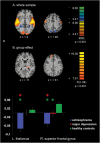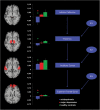Impaired Subcortical Detection of Auditory Changes in Schizophrenia but Not in Major Depression
- PMID: 31220318
- PMCID: PMC6942154
- DOI: 10.1093/schbul/sbz027
Impaired Subcortical Detection of Auditory Changes in Schizophrenia but Not in Major Depression
Abstract
The mismatch negativity is a cortical response to auditory changes and its reduction is a consistent finding in schizophrenia. Recent evidence revealed that the human brain detects auditory changes already at subcortical stages of the auditory pathway. This finding, however, raises the question where in the auditory hierarchy the schizophrenic deficit first evolves and whether the well-known cortical deficit may be a consequence of dysfunction at lower hierarchical levels. Finally, it should be resolved whether mismatch profiles differ between schizophrenia and affective disorders which exhibit auditory processing deficits as well. We used functional magnetic resonance imaging to assess auditory mismatch processing in 29 patients with schizophrenia, 27 patients with major depression, and 31 healthy control subjects. Analysis included whole-brain activation, region of interest, path and connectivity analysis. In schizophrenia, mismatch deficits emerged at all stages of the auditory pathway including the inferior colliculus, thalamus, auditory, and prefrontal cortex. In depression, deficits were observed in the prefrontal cortex only. Path analysis revealed that activation deficits propagated from subcortical to cortical nodes in a feed-forward mechanism. Finally, both patient groups exhibited reduced connectivity along this processing stream. Auditory mismatch impairments in schizophrenia already manifest at the subcortical level. Moreover, subcortical deficits contribute to the well-known cortical deficits and show specificity for schizophrenia. In contrast, depression is associated with cortical dysfunction only. Hence, schizophrenia and major depression exhibit different neural profiles of sensory processing deficits. Our findings add to a converging body of evidence for brainstem and thalamic dysfunction as a hallmark of schizophrenia.
Keywords: auditory processing; depressive disorder; major; mismatch negativity; schizophrenia.
© The Author(s) 2019. Published by Oxford University Press on behalf of the Maryland Psychiatric Research Center. All rights reserved. For permissions, please email: journals.permissions@oup.com.
Figures



Similar articles
-
Abnormal Effective Connectivity in the Brain is Involved in Auditory Verbal Hallucinations in Schizophrenia.Neurosci Bull. 2017 Jun;33(3):281-291. doi: 10.1007/s12264-017-0101-x. Epub 2017 Feb 21. Neurosci Bull. 2017. PMID: 28224285 Free PMC article.
-
Auditory mismatch impairments are characterized by core neural dysfunctions in schizophrenia.Brain. 2015 May;138(Pt 5):1410-23. doi: 10.1093/brain/awv049. Epub 2015 Mar 4. Brain. 2015. PMID: 25743635 Free PMC article.
-
A 7 Tesla fMRI investigation of human tinnitus percept in cortical and subcortical auditory areas.Neuroimage Clin. 2020;25:102166. doi: 10.1016/j.nicl.2020.102166. Epub 2020 Jan 11. Neuroimage Clin. 2020. PMID: 31958686 Free PMC article.
-
Intracortical mechanisms of mismatch negativity dysfunction in schizophrenia.Audiol Neurootol. 2000 May-Aug;5(3-4):207-15. doi: 10.1159/000013882. Audiol Neurootol. 2000. PMID: 10859415 Review.
-
The interhemispheric miscommunication theory of auditory verbal hallucinations in schizophrenia.Int J Psychophysiol. 2019 Nov;145:83-90. doi: 10.1016/j.ijpsycho.2019.02.002. Epub 2019 Feb 7. Int J Psychophysiol. 2019. PMID: 30738815 Review.
Cited by
-
Functional connectivity signatures of NMDAR dysfunction in schizophrenia-integrating findings from imaging genetics and pharmaco-fMRI.Transl Psychiatry. 2023 Feb 16;13(1):59. doi: 10.1038/s41398-023-02344-2. Transl Psychiatry. 2023. PMID: 36797233 Free PMC article. Clinical Trial.
-
A Computational Account of the Development and Evolution of Psychotic Symptoms.Biol Psychiatry. 2025 Jan 15;97(2):117-127. doi: 10.1016/j.biopsych.2024.08.026. Epub 2024 Sep 10. Biol Psychiatry. 2025. PMID: 39260466 Review.
-
Deficits in Pre-attentive Processing of Spatial Location and Negative Symptoms in Subjects at Clinical High Risk for Schizophrenia.Front Psychiatry. 2021 Feb 2;11:629144. doi: 10.3389/fpsyt.2020.629144. eCollection 2020. Front Psychiatry. 2021. PMID: 33603682 Free PMC article.
-
Pitch and Duration Mismatch Negativity are Associated With Distinct Auditory Cortex and Inferior Frontal Cortex Volumes in the First-Episode Schizophrenia Spectrum.Schizophr Bull Open. 2021 Feb 23;2(1):sgab005. doi: 10.1093/schizbullopen/sgab005. eCollection 2021 Jan. Schizophr Bull Open. 2021. PMID: 33738454 Free PMC article.
-
SpaDE: Semantic Locality Preserving Biclustering for Neuroimaging Data.bioRxiv [Preprint]. 2024 Jun 10:2024.06.08.598092. doi: 10.1101/2024.06.08.598092. bioRxiv. 2024. Update in: Annu Int Conf IEEE Eng Med Biol Soc. 2024 Jul;2024:1-5. doi: 10.1109/EMBC53108.2024.10782417. PMID: 38915715 Free PMC article. Updated. Preprint.
References
-
- Möller HJ. Systematic of psychiatric disorders between categorical and dimensional approaches: Kraepelin’s dichotomy and beyond. Eur Arch Psychiatry Clin Neurosci. 2008;258 (suppl 2):48–73. - PubMed
-
- Fitzgerald PJ. Gray colored glasses: is major depression partially a sensory perceptual disorder? J Affect Disord. 2013;151(2):418–422. - PubMed
-
- Umbricht D, Krljes S. Mismatch negativity in schizophrenia: a meta-analysis. Schizophr Res. 2005;76(1):1–23. - PubMed
-
- Escera C, Alho K, Winkler I, Näätänen R. Neural mechanisms of involuntary attention to acoustic novelty and change. J Cogn Neurosci. 1998;10(5):590–604. - PubMed
Publication types
MeSH terms
LinkOut - more resources
Full Text Sources
Medical

